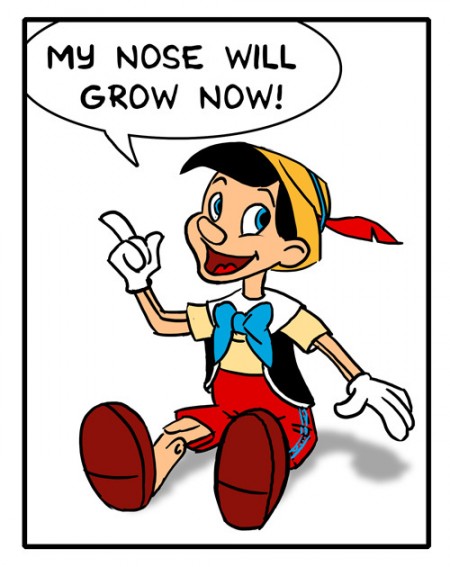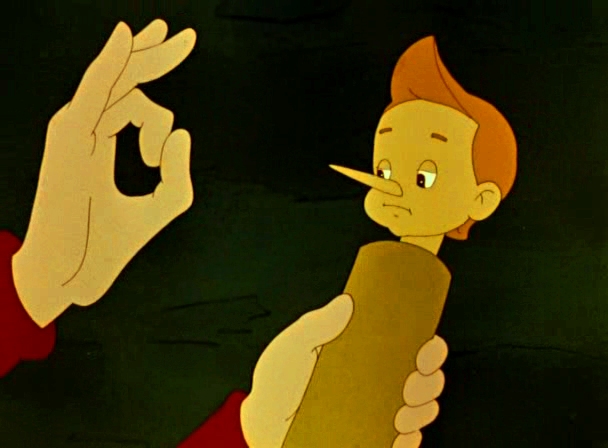|
Similarity and difference of works |
||||||||
|
The book of Karlo Kollodi combines fabulousness, cheerful imagination of the author and the original real world included in this fabulousness. All its characters: the speaking cricket , the fox, the cat, the fisherman, the inhabitant of "the country of the fools╗ have real prototypes in the Italian reality. Critics define the style of a fairytale as ½fantastic realism╗ which is often accompanied by the lively folk humour frequently transforming and even satire. The tradition of ½comedies of masks╗ plays a big role in the story. After all Pinokkio is taken therefrom. The author constantly reminds the reader about it: when the wooden boy gets to the company of theatrical puppets they accept him; and actions of a tale, a plot are being built by the laws. Not in vain it is easy to play at the theatre that is being done both in Italy and in Russia successfully .
Throughout the book Pinokkio into different situations,experiences a lot of adventures which are not a chain ofaccidents at all. They are united by common themes whichhave deep moral, humanistic sense. Silly,self-confident,thoughtless Pinokkio receives lessons of behavior, educationfrom the life. All those lectures which he hears from hisfather, a talking cricket, a fairy have no value till Pinokkio is not convinced it by correctness, justice in practice. Main "tutors" of the wooden boy ¢ deprivations, hunger, collisionswith dishonest people. He receives salutary lessons from the behavior of kind andwarm people, clever and noble animals ¢ a tuna, a dog, the falcon and others too. Original punishment for offences is not a rebuke but asinine ears, the long nose which he received. Working, studying, helping others Pinokkio turns into a well- educated boy, real person. That is the main idea of the fairy tale. It shows us how difficult is to become a real person, to find a live soul, how many obstacles and temptations is necessary to overcome on this way. Now we will consider the contents of the "The little gold key" in the system of deviations from the original, i.e. from "The adventures of Pinokkio" because these deviations are much more serious in the sense of the ethical plan versus they are interpreted by M.S.Petrovsky. Pinokkio becomes clear morally in his adventures and tests and finds soul, becomes a real boy. Buratino remains a wooden doll, and it is hardly possible to agree with M.S.Petrovsky that "to transform Buratino into a person would be absurd - he is the person". The plot of this "fairy tale" contains author's deliberate opposition of the wooden little man to real people; it is one of the most notable ethical moments which were underlined by the author. So the image of Buratino can be considered as an image of the real person only in the sense of a quite concrete person who has features of a specific and the absence of such transformation in the plot includes concrete moral author's estimation - Tolstoy's negative attitude to any real person.
Secondly, not a less important difference of "the Golden key" from "The adventures of Pinokkio" - a scene of action. Only the Country of the Fools only is taken from "the little gold key" included all other places (including the Country of Hardworking Bees) are not included. It is necessary to get a grasp more attentively where exactly Buratino lives and wanders. Outwardly everything looks as it`s clear - there is "a small town on the bank of the Mediterranean " and there is a City of Fools in the Country of the Fools (Bolvaniya in K.Kollodi`s work). The border of the Country of the Fools is accurately outlined too - "behind the broken bridge through the dried up stream". But the heroes of a fairy tale scurry about there and backwith ease, Duremar collects bloodsuckers in a pond near the City of the Fools; the fox Alice and Karabas Barabas address to the local police without ceremony and policemen in the City of Fools wear the same triangular hats as policemen in small town on a hillock. Karabas Barabas breaks to a closet of Karlo by "a name of the Tarabarsky king". And this combination - "the Tarabarsky king" - meets four times on one and a half pages! The author meaningly draws attention to it and only in the end of the tale we find out that "the small town on a hillock" is in Tarabarsky country. One of the meanings of
the word "Tarabarsky" - "senseless".
Then all the events occur in one state but the author deliberately mixed "a political card" of his "fairy tale". By the way, we will pay attention to the following details: When Buratino went to school, "he even did not look at the sweets exposed in benches at all , - papaverous triangles on honey , sweet pies and sugar candies in the form of cocks putting on a stick". And here is how the fox of Alisa tells about the City of the Fools: "In this city well-known jackets on hare fur are on sale... Ah, what sweet pies and lollipops are on sale!" The lop-sided belltowers in the City of the Fools also fall under the sign symbols of Russia. There are not two different countries and A.N.Tolstoy confirms about "particularly taken country" in the play "The little gold key" - there all events occur in the country of the Tarabarsky king, the pond with Tortilla is "near capital of Tarabarsky king". So, the notorious Country of the Fools has obviously recognized features of Russia which one what - imperial or Soviet? The answer arises from that in a Soviet period it was possible to laugh over imperial Russia freely . But to confirm about it unequivocally is possible only on the basis of the facts which specify the characteristic signs of that time. A.N.Tolstoy's fairy tale ½The golden key╗ uses some motives of Kollodi`s tale but it changes an original plot strongly enough. Up to a scene of coins`s buring in the Field of Miracles the plot of Buratino and Pinokkio develops almost equally with a difference in fine details (for example, instead of Malvina there is a Fairy with the appearance of Malvina). But after digging out the coins by the cat and the fox which were buried by Buratino there will be no plot coincidences to Pinokkio don`t meet any more. As a name of the main character the word of Buratino is chosen(ital. burattino Ś a puppet, a doll, the clown)and it is in the title of the Kollodi`s book too. One of the main differences of Tolstoy`s tale from a fairy tale of Kollodi ¢ the absence of morality. "The adventures of Pinokkio" ¢ is a frank and full the moralising work. Almost each episode is accompanied by vast moral maxims. The author moralizes, its heroes do ¢ both Karlo, and the fairy with blue hair, and a cricket, and squirrel, and a dog of Alidoro (a prototype of Artemon), and Pinokkio moralizes. In Kollodi`s tale everybody moralizes , in Tolstoy`s one ¢ nobody. Pinokkio of Tolstoy is much more naughty than Pinokkio of Kollodi who was burdened with this ballast. The author's relation to the hero varies also: instead of preceptorship we
see an admiration.
The character of Buratino is shown in constant development; the heroic beginning in the wooden boy is often looked through outwardly comic. So, after brave fight with Karabas Malvina forces Buratino to write a dictation but he instantly thinks out an excuse: "Writing-materials haven`t been taken". Buratino is loved by children that he is successful not only in a fantastic way but also has originally human weaknesses and lacks. Buratino does not change his character and appearance till the end of a book plot. It ruthlessly stops all attempts of his re-education of daddy Karlo and Malvina. He remains a doll. Pinokkio listens to constant re-education and in the end of the book he becomes the brought up boy who had left a doll mask. And one more of the main differences: in the Italian fairy tale there is no main image of a Buratino tale, there is no its key metaphor and the most significant symbol ¢ a gold key. One more essential difference of "The adventures of Buratino" from "Adventures of Pinokkio" - the romance of Pero and Malvina. Landscapes of Kollodi differ from Tolstoy's landscapes. Instead of the vast description of a night thunder-storm - with a wind howl, a thunder, a lightning and other fake effects - Tolstoy enters: "Trees rustled, shutters clapped", - and all the picture of disturbing night is ready.
Some other details: daddy Karlo unlike Dzheppetto was not put in prison, Instead of a fox there is a dog-fox, the drawn copper is present in the fireplace, seigneur Mandzhafoko (analogue of Karabas) does not ask Pinokkio about the drawn copper and does not mention the Golden Key though gives five gold coins too, unlike Pinokkio Buratino does not make traumatic amputation of a cat`s paw at an attack of robbers, instead of Malvina there is a fairy with the same appearance and the same poodle, there is no admirer of Malvina Ś Pero. Unlike Buratino the long nose of Pinokkio becomes longer when he tells lies. Tolstoy kept and strengthened that what had made a fairy tale of Kollodi a tale for children and provided it with mighty popularity - a narrative saturation, an abundance of freakish episodes and fantastic adventures, unexpected turns of action from ridiculous to terrible and back. All fairy tale has moved: turned from the world of adult in the world of children by Kollodi, it began to come nearer to the idea of the children's world in TolstoyÆs writings . Till the meeting with the Cricket the story about Buratino goes in the storyis tracks about Pinokkio. From this point the editing went in a large way and outgrew in free creativity; it became impossible to continue work on a printing copy. The remark of the Cricket ¢ the point of rupture of A. Tolstoy from K.Kollodi and the beginning of prompt approach of a fairy tale to problems and means of actually creativity of Tolstoy. The archive testifies that for three months of work the writer had rewritten the whole fairy tale from beginning to the end for several times. The happiness which is found by dolls appears in front of them in the image of ideal utopian theatre. Own theatre is a native element of heroes of a fairy tale, fatherland`s dolls. The fairy tale for children got value and important for A. TolstoyÆs adult readers and, first of all, for the author himself. Widespread representation about the limited originality of the fairy tale of A. Tolstoy, about its secondariness in relation to the fairy tale of Kollodi - is
categorically incorrect.
For "the little gold key" the Italian fairy tale served only a launching pad, knowing nothing about the flight, To speak about the dependence of "The adventures of Buratino" from "The adventures of Pinokkio" means to speak about dependence of "A long ordeal" , trilogy of Tolstoy, from the Old Russian story "The virgin`s Circulation on torments" .While working at the fairy tale the thought of the artist was much more occupied by the novel which he postponed and to which he would return than by the fairy tale of Kollodi. |




